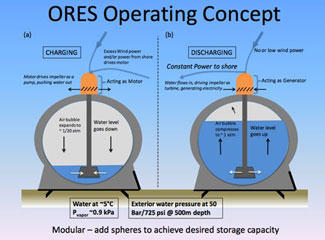Researchers at MIT are working on a way to solve the intermittency problem of offshore wind by creating an energy storage system made from huge concrete spheres.
The spheres, which weigh thousands of tons each, would be placed on the seafloor under floating wind turbines. They would anchor the turbines as well as store energy for them, which would be released as needed.
When wind turbines produce excess power, it would be diverted to drive a pump that’s attached to a sphere, removing seawater from a 30-meter-diameter hollow sphere – about the size of the dome on the US Capitol. Later, when power is needed, water would be allowed to flow back into the sphere through a turbine attached to a generator, and the resulting electricity would be sent to shore.

One sphere in 400-meter-deep water could store up to 6 megawatt-hours of power. If spheres were attached to 1,000 wind turbines, that could replace an average coal or nuclear plant. And the energy source would be available (or taken off-line) in minutes, unlike coal or nuclear, which take hours to ramp up.
With the system connected to the grid, the spheres could also store energy from other sources, such as onshore solar plants.
Their heavy weight would keep the spheres steady on the seafloor even when they’re empty. They would be cast on land and towed out to sea.
Researchers estimate it would cost about $12 million per sphere, or 6 cents per kilowatt-hour for energy storage- a level considered viable by the utility industry. The price would come down as more are deployed.
A prototype has been functioning well through charging and discharging cycles, demonstrating the feasibility of the idea.
Unfortunately, a lot of concrete is required, as much as used to build the Hoover Dam, say the researchers, but it would also supply a comparable amount of power.
Because cement production is a major source of carbon emissions, the concrete could be made partially from fly ash, a waste product from coal plants. Over 10 years, researchers believe most of the fly ash produced by US coal plants could be absorbed by the spheres, while creating the capacity to supply a third of US electricity needs.
Learn more:

As an experienced developer, I see several problems with this approach. The first is the potential impact on marine life. As the wave technology people know, this is a big issue without a lot of historical (or any other kind of)data to go by. Second, maintenance will be expensive and frequent. A motor/generator connected to a pump several hundred feet below the sea will be pretty hard to get to. If the motor/generator on a full scale unit needs to be cooled (likely in my view), you will need an underwater heat exchanger that’s reliable and won’t leak.
I think if you put the M/G on one of the wind platforms, you’d be better off even with a lot of pipes. The valves would still have to be at the bottom, but they are more reliable.